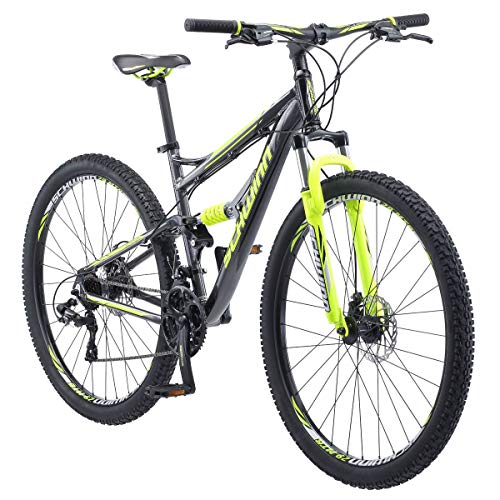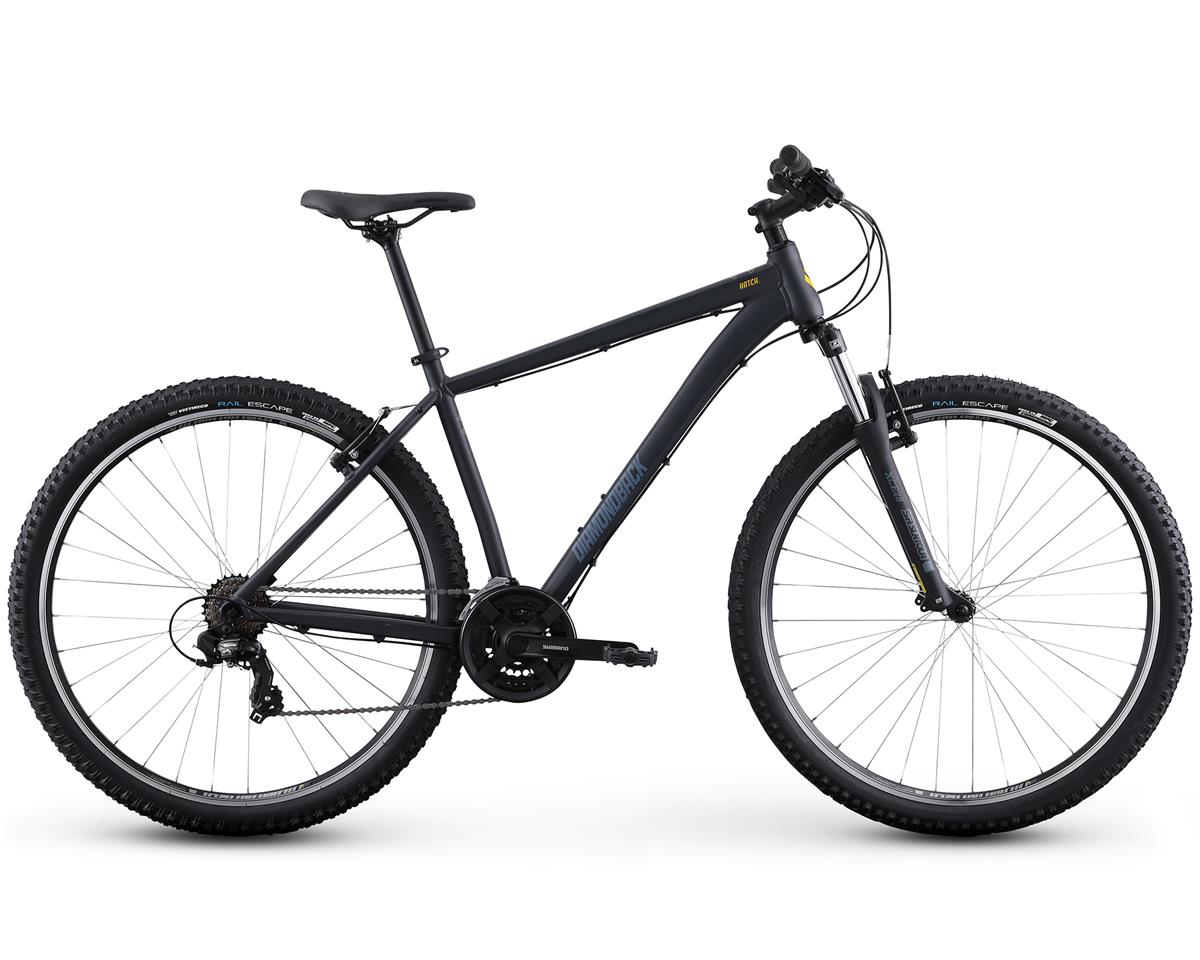Though heading out through the mountains on a road bike is a great experience, but to really interact with nature, you have to go off-road. A mountain bike is your best choice for going off-road on two wheels. They can be expensive, but they don’t have to be. To show you what to expect, I’ve compiled a general guide to find the best cheap mountain bike and added reviews of 5 models for comparison. In this article I’m going to review the following 5 best mountain bikes under $500:
- Schwinn High Timber Mountain Bike (MY FAVORITE)
- Hiland 27.5″ Mountain Bike
- Schwinn Traxion Mountain Bike
- Gravity FSX 2.0 Dual Full Suspension Mountain Bike
- Batch The Mountain 29”
- Diamondback Hatch 27.5″
- Mongoose Impasse
Best Mountain Bike Under 500 Dollars Review
Taking the information from the section down under, you are better able to make an informed comparison between the bikes in my reviews.
Pay attention to the various features and consider how they will best serve the type of riding you want to do and the type of terrain you are apt to encounter.
1. Schwinn High Timber Mountain Bike (MY FAVORITE)
Specifications
Frame: Aluminum frame
- Brakes: Mechanical disc
- Speed Settings: 3×7
- Shifters: Shimano
- Weight: 39 lbs
The Schwinn High Timber Mountain Bike is well named. This hardtail is what most people think of when they hear the term mountain bike.
You get some of the best mountain bike features available at a price that is a little above the median range. To start off, this bike features 29 inch wheels, providing a better attack angle around objects for a smoother ride.
You get the benefits of shock absorption in your hands and arms as you manipulate this bike over rugged terrain due to its front suspension, but you get a little more climbing power because it is a hardtail.
These features come on a lightweight, durable aluminum alloy frame.
Disc brakes on both the front and rear wheels of this bike combine lower maintenance with improved stopping efficiency, and they are mechanically activated to keep the price down.
The dependable gearing components on this mountain bike match those of the Protocol 1.0 with 3×7 gearing executed by the Shimano shifter and Shimano derailleur.
PROS
-
Durable, lightweight, aluminum alloy frame
- Hardtail suspension provides more climbing power.
- 29 inch wheels for smoother ride.
- Shimano gearing components.
- Disc brakes.
CONS
-
Limited Gearing
- No lock-out on front suspension
2. Hiland Mountain Bike
Specifications
Frame: Aluminum frame
- Brakes: Disc
- Speed Settings: 27
- Shifters: Shimano EZ Fire
- Weight: 43 lbs
The Hiland is slowly becoming one of the most popular bikes currently on the market when it comes to budget mountain bikes.
You will pay a little bit more than the median range price of this category for a pretty decent bike if you choose this model.
Like the Schwinn Bonafide, this bike rolls on 27.5″ wheels for a smoother ride over rough terrain. It has great handling and is a beast on the corners.
Like both models, it is built on an aluminum alloy frame. The combination of these features makes it a pretty smooth and easy handling mountain bike for all levels of riders.
Like the Bonafide, the Hiland uses mechanical disc brakes on both the front and rear wheels for improved stopping power. This bike is geared just like both of the other bikes, providing 27 gear choices on a 3×9 system that features Shimano components.
PROS
-
Lightweight, durable aluminum alloy frame.
- 27.5″ inch wheels for a smoother ride.
- Full-suss for better handling and control.
- Shimano gearing components.
CONS
-
3×9 gearing sets you up to do more maintenance.
3. Schwinn Traxion Full Dual-Suspension Mountain Bike
Specifications
Frame: Aluminum frame
- Brakes: Mechanical disc
- Speed Settings: 24
- Shifters: Shimano EZ Fire
- Weight: 49 Pounds
The Schwinn Traxion is our first full suspension mountain bike on this list and it is incredible.
You will pay a little bit more than the median range price of this category for a pretty decent bike if you choose this model.
Like the Schwinn Bonafide, this bike rolls on 29ers for a smoother ride over rough terrain. Like the Schwinn Protocol 1.0, it is a full-suss bike.
Like both models, it is built on an aluminum alloy frame. The combination of these features makes it a pretty smooth and easy handling mountain bike for all levels of riders.
Like the Bonafide, the Traxion uses mechanical disc brakes on both the front and rear wheels for improved stopping power. This bike is geared just like both of the other bikes, providing 24 gear choices on a 3×8 system that features Shimano components.
PROS
-
Lightweight, durable aluminum alloy frame.
- 29 inch wheels for a smoother ride.
- Full-suss for better handling and control.
- Shimano gearing components.
CONS
-
3×8 gearing sets you up to do more maintenance.
- Needs lockouts on suspension system.
4. Gravity FSX 2.0 Dual Full Suspension Mountain Bike
Specifications
Frame: Aluminum frame
- Brakes: Disc
- Speed Settings: 24
- Shifters: Shimano EF51
- Weight: 20 Pounds
The 2018 Gravity FSX 2.0 Dual Full Suspension Mountain Bike adds some additional quality that the other bikes don’t have without pushing it over the $500 price point.
Its included features are what advanced users tend to look for.
This full-suss bike comes with 26” double-wall alloy wheels. Both the front and rear suspension systems on this bike have lockout features to allow better power distribution during a climb as well as the capacity to adjust the level of absorption to improve your ride over varying intensities of terrain.
These features are mounted on an aluminum alloy frame, so your bike remains lightweight and easy to maneuver.
Tektro Novello disc brakes on a mechanical system are featured on this bike, adding to the quality components of this bike. More quality components are present in the gear system of this bike, which gives you 24 gears (3×8) to choose from.
Shimano Acera components are used in the derailleurs and higher end Shimano EF51 shifters are added for changing gears, in order to round out the quality built into this bike.
PROS
-
Lightweight, durable aluminum alloy frame.
- Full-suss with front and rear lockout.
- Rear suspension can be adjusted to various shock absorption levels.
- Quality disc brakes.
- Quality Shimano shifters and gearing components.
CONS
-
26 inch wheels instead of 29 inch wheels, will make it ride rougher.
- Lots of adjustable parts.
5. Batch The Mountain 29”
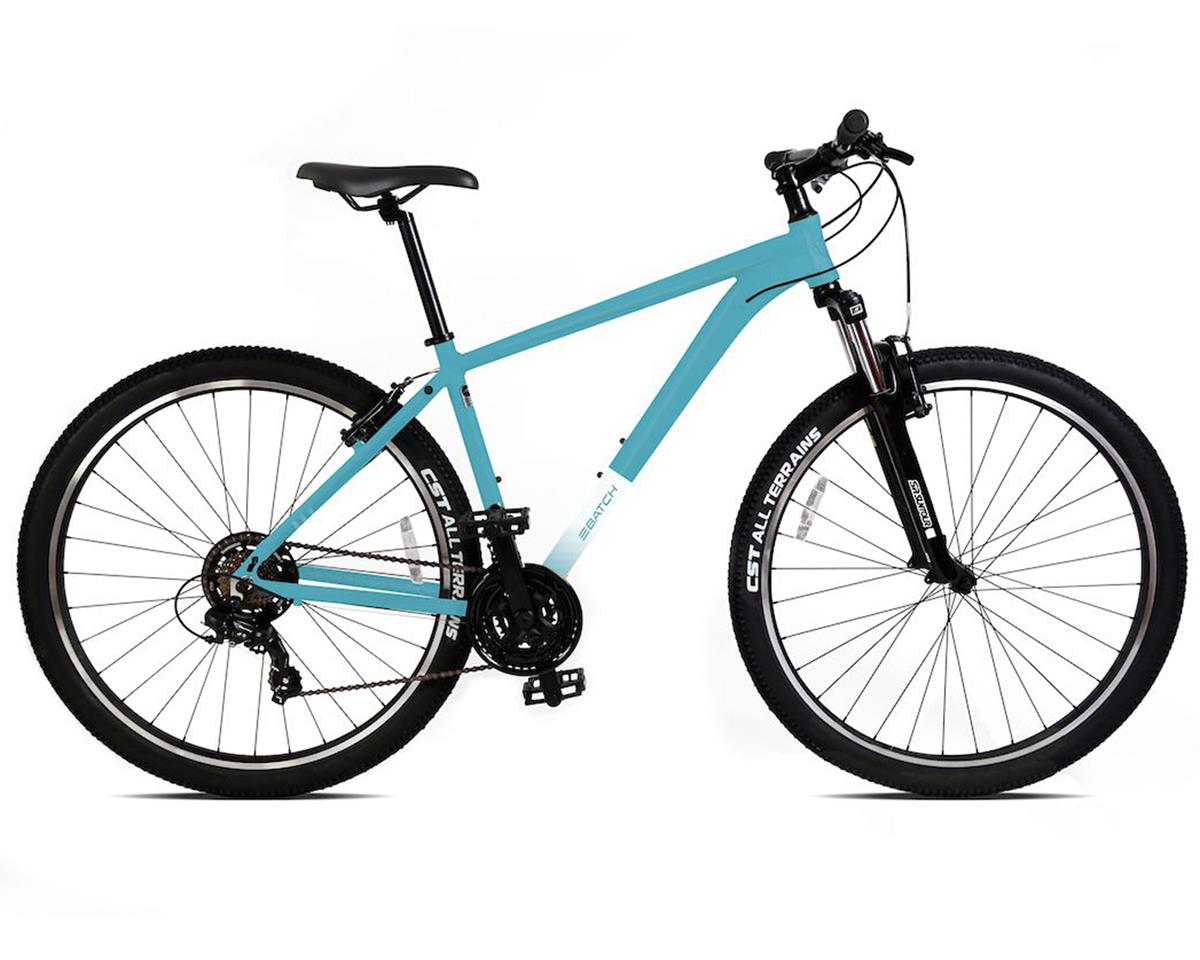
Specifications
Aluminum Frame
- 21 Speed Gearing System
- Reliable V Brakes
- Suspension
- Rapid fire shifters
The Batch Bicycles 29″ mountain bike is an incredible bike for nearly half the price of our $500 budget. It has so much to offer, and we can see why so many people turn to using this bike.
Firstly the frame design is excellent. The bike is made of aluminum, so it is pretty light and very strong. It is bold in color and stands out in a crowd in orange or hides in a stealthy grey. The geometry is very relaxed, and it is going to offer you a lot of comfort when riding it.
It has 29” wheels that will feel super agile and, with a high spoke count, are going to offer a tremendous amount of protection and be highly durable. They are equipped with CST All Terrain 2.1” tires.
It is equipped with Suntour suspension forks giving you 100mm travel at the front. Suntour is a trendy brand in budget mountain bikes and works fantastically.
The gearing is the Shimano, so you know you are getting really high-quality components that will last. It’s a 3×7 Speed. It gives you 21 different gear ratios to pick, and it’s going to make getting up those hills easy.
The only thing that we’re not so keen on with this bike is the Rim brakes. What would have made this bike perfect for the price would have been disc brakes. All in all, it is half the budget price and will be an excellent bike to hit a trail on or even commute to work if you want to.
PROS
-
A lightweight frame with color options
- Great low-end gearing
- Suntour Fork with 100mm travel
CONS
-
Rim Brakes
6. Diamondback Hatch 27.5″
Specifications
Aluminum Frame
- 21 Speed Gearing System
- Reliable V Brakes
- Front Suspension
The Diamondback Hatch is a very cool bike and sits right around the $500 price range. It’s a great bike and comes from an excellent brand, so you know you’re getting high quality.
The Frame is aluminum. It’s light, it’s strong, and it’s going to offer you an excellent ride. It’s got great geometry and is suitable for all day comfort.
The wheels are 27.5,” and they are equipped with 2.25” tires. These are going to offer you excellent grip, and also they are pretty smooth for the road.
The suspension is a Suntour fork. It offers 100mm of travel on a coil spring system. It’s a very reliable component and will require very little maintenance over its life.
The groupset is the Shimano TZ500 3×7 Speed; it offers a great range and a vast amount of gears when getting up a steep hill or going through rough terrain surfaces.
Like many of the bikes on this list, the brakes are rim brakes. They are not as powerful as discs but will still stop you fast.
PROS
-
Giant Quality Frame
- Shimano Gearing Setup
- Suntour Fork
CONS
-
Rim Brakes
7. Mongoose Impasse
Specifications
Aluminum Frame
- 21 Speed Gearing System
- Powerful Disc Brakes
- Dual Suspension
- Rapid fire shifters
A full-suspension mountain bike for less than $500. Yes, you are seeing it here! The Mongoose Impasse is an incredible bit of kit for a super low cost, and you need to know about it.
Firstly the frame, Mongooses high-quality aluminum, and it comes in a beautiful silver or charcoal. Mongoose has been in the bike industry for years and makes a strong frame ready for some serious trails.
The wheels are 29”, perfect for making the bike capable of getting over some big lumps in the road and backing up that twin suspension. You don’t often see too many 29” bikes at such a low price point. Typically, they are 26” or 27.5”.
The Dual suspension is incredible and not often seen on bikes at this price. It is going to equip you for more demanding trails than most bikes in this price range, but it does increase the weight of the bike.
The Shimano 3×7 Groupset is excellent and seen on many bikes on this list. It has excellent quality and capability. Finally, the bike is equipped with disc brakes, unlike many bikes on this list, and is going to give you incredible stopping power in wet and dry conditions.
PROS
-
Dual Suspension
- Looks Amazing
- Disc Brakes
CONS
-
It will be fairly heavy
Buying Guide to Find the Best Cheap Mountain Bike
To make a qualified choice between one mountain bike and another, there are several features to compare and four questions that you will want to ask yourself to narrow it down.
What are the advantages of a mountain bike?
The main advantage of a mountain bike over a road bike is its ability to take more abuse without breaking down.
Like road bikes, mountain bikes are lightweight and geared for climbing and acceleration, but that’s where the two part ways. Mountain bikes also add lateral stiffness and do a better job of absorbing vibrations along with sudden jars.
They tend to be equipped for getting better traction on various types of off-road terrain and perform better in less than ideal conditions.
What are the various classes of mountain bikes?
Different people have different definitions for a mountain bike. Part of defining mountain bikes relates to what sort of terrain a person is riding.
There are four classes of mountain bikes. Each class includes distinguishing features and is valued for different types of terrain and uses. (1)
The most common distinguishing features between them are suspension travel, which measures the amount of movement offered by the bike’s front and rear suspension, and head-tube angle.
A shallower head-tube angle provides greater stability in turning and a steeper head-tube angle improves climbing.
Trail Bikes
The most common mountain bike is the trail bike. Trail bikes are not designed for any type of racing or competition.
Their main purpose is more casual with fun and efficiency being of more value.
However, casual doesn’t mean that these bikes are wimpy. Common features on trail bikes are:
- 120mm to 140mm suspension travel.
- 67º to 69º head-tube angle.
These bikes aren’t as tight and are built for stability more than for aggressive climbing. A trail bike will get you there and back, but their performance features make them less than ideal for competition.
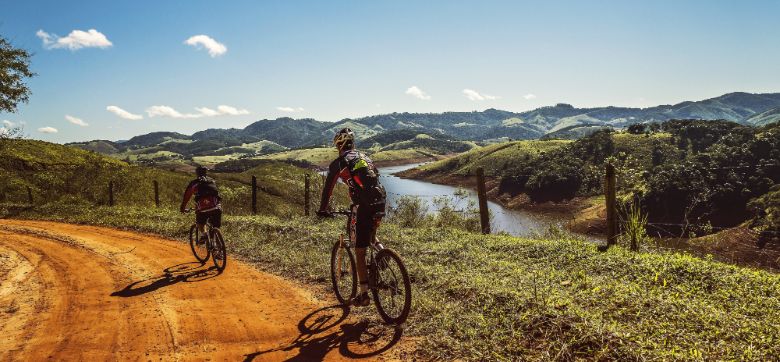
Cross-Country Bikes
Cross-country bikes are mountain bikes that are built for competition. Their strength is in faster riding and rapid climbing.
These bikes tend to carry their riders greater distances with a greater amount of performance efficiency. The distinguishing features of this bike include:
- 80mm to 100mm of suspension travel.
- 70º to 71º head-tube angle.
If you want to get competitive in mountain biking, then this is the bike you’re looking for.
All-Mountain Bikes
This type of bike is for those who live a little bit more on the edge than the average mountain biker. This type of trail riding focuses on bigger, leg-burning ascents and longer, thrill-enhanced descents.
These bikes require more technical skill to ride and are lighter and more nimble. They feature:
- 140mm to 170mm of suspension travel.
- 65º to 68º head tube angle.
If you plan to take mountain biking to the extreme, then this is the bike for you.
Fat Bikes
Fat tire bikes sort of break the rules as far as the distinguishing features above. Their main superpower is providing phenomenal traction in sand, snow or mud.
They are distinguished by fat tires measuring between 3.7” to 5” (or more) in width.
They are great for beginners because they provide greater stability and are more forgiving, but experienced riders also love them because they allow them to ride over terrain that would bring other bikes to a screeching hault.
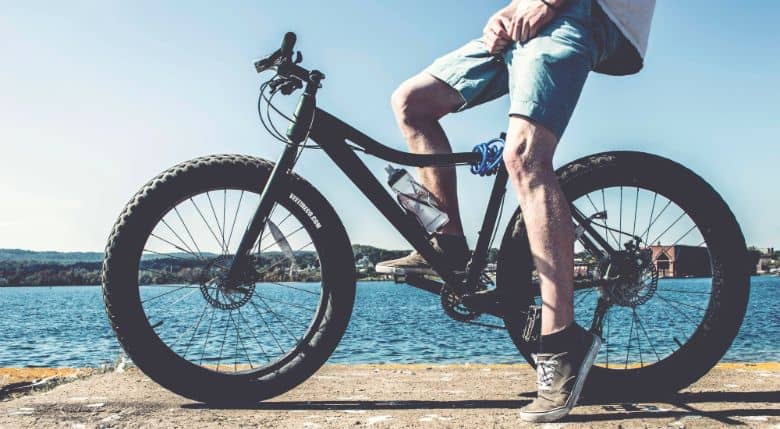
Different Price Ranges between Mountain Bikes
If you already visited the homepage of my site, you may have noticed I there are some other pages about mountain bikes.
Mountain Bikes Under 300 Dollar
If you are under the budget of $500, I advise you to visit the page all about mountain bikes under $300 right here.
Mountain Bikes Under 1500 Dollar
When you have more budget to spend, don’t forget to check this page. Here you find all the reviews about the best mountain bikes under $1500.
What features should you look for in a mountain bike?
Several features should be in mind when comparing mountain bikes. The first two, wheel size and suspension type, are the most important features associated with the type of terrain your bike will handle.
However, frame material, gearing, and brakes are also important features for comparison as well. (2)
Wheel Sizes
There are two extremes in mountain bike wheel sizes and one size that creates middle ground between them. The difference is how they roll over rough terrain. They include:
- 26 inches (26ers), which are less smooth on rough terrain.
- 27.5 inches, which roll a bit smoother than 26ers.
- 27.5+ inches, which are the same wheel diameter, but have tire width in excess of 2.8”
- 29 inches (29ers), which provide the smoothest ride.
26ers are less popular than they once were, because they aren’t as smooth to ride. 29ers tend to be the preferred choice of cross-country bikers, because they are more efficient for long rides.
The vast majority of mountain bikes fall in between these two extremes.
Suspension Types
Suspension types are another factor to compare when choosing a mountain bike in any of the four classes.
There are three different types of suspension and each one has advantages and disadvantages for various types of terrain and usage.
- Rigid. A rigid bike is a bike that has no suspension system of any kind. These are not very common among the majority of mountain bikes. However, rigid frames are found among those who ride fat bikes, because the wider tires provide shock absorption on the trail. Rigid bikes are easier to maintain and are less expensive.
- Hardtail. This style of suspension provides suspension in the fork (the front of the bike), while leaving the rear of the bike rigid. This allows for shock absorption for better steering control, but limits the amount of maintenance a full-suspension requires. Most hardtails allow you to lock out the suspension on the front fork to make the bike fully rigid when desired. This is the most common suspension on mountain bikes of all classes because they transfer more power per pedal stroke to the rear tire for climbing.
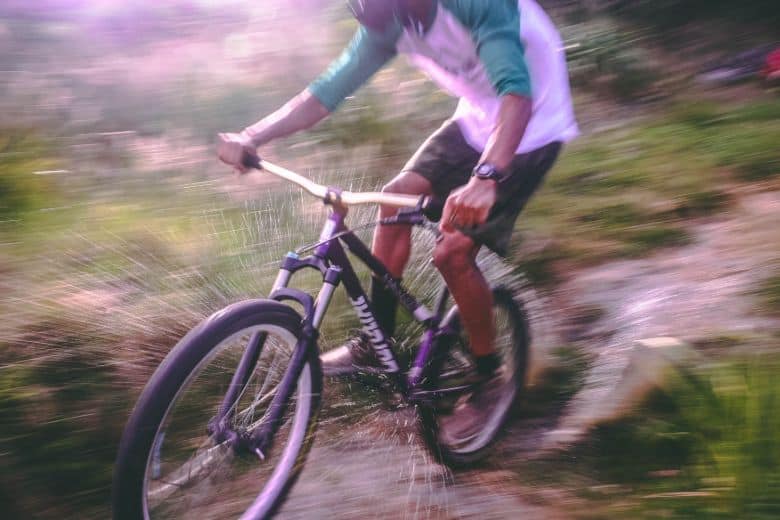
- Full suspension (full-suss). Though there are a variety of ways that full-suss is achieved, the main idea is to provide shock absorption on both the front and the rear. This type of suspension provides the smoothest ride, but requires a greater amount of maintenance than either of the other two types and they don’t perform as well when climbing.
Frame Materials
It is no surprise that the weight, strength and durability of a mountain bike are in its frame, but the bike’s frame also influences ride quality and price. Various materials are used in building frames, including:
- Steel. Tough and inexpensive, provides a smooth ride, but is heavy. Is found on lower-end mountain bikes and fat bikes.
- Titanium. Tough and lighter, but too expensive (not found on any bike under $500).
- Carbon Fiber. Also tough and lightweight, but expensive. It is found on all classes of mountain bikes, but not the ones under $500.
- Aluminum Alloy. Lightweight and durable enough to handle rough terrain. This is the go to choice for mountain bike frames.
Brakes
When it comes to brakes, there are two different types of brakes and two different system types. The two types are disc brakes and rim brakes.
The two systems types are hydraulic and mechanical. Here is a quick description of each of these brake components:
- Disc brakes. Feature brake pads, which grip a brake rotor mounted on the wheel hub. They work pretty much the same way as the brakes on your car.
- Rim brakes. Feature pads that grip the rim of your wheels to provide braking. These are pretty common on entry level bikes in all classes.
- Hydraulic brake systems. Use fluid pressure to control braking. These systems require less effort to obtain more progressive and stronger braking capacity. They adjust as brake pads wear.
- Mechanical brakes. Aka cable-activated brakes, use cable inside of hard plastic tubing to activate braking. They take more effort to provide braking and have to be manually adjusted as brake pads wear.
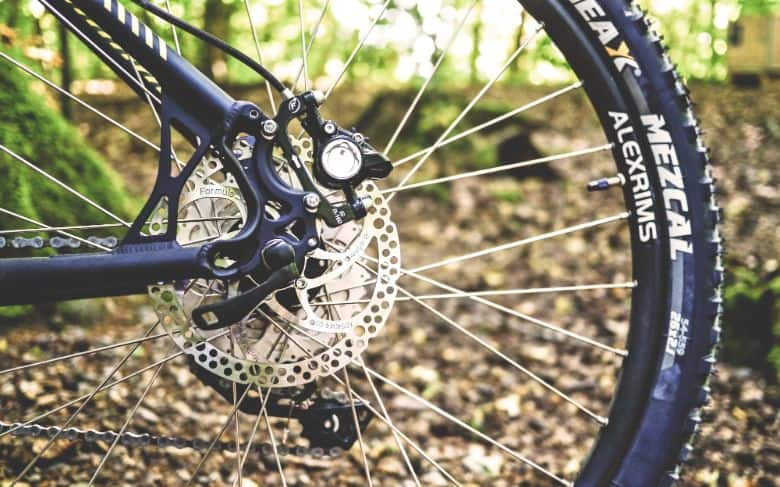
Gears
A discussion of gearing for mountain bikes could be the focus of an extensive article. We’ll keep it simple.
Gearing on a mountain bike will be based on the number of chainrings on the crankset, which is where the pedals are, multiplied by the number of sprockets on the cassette, or rear drivetrain of the bike.
Traditional gearing on mountains bikes has been focused on multiple chainrings on the crank (2 to 4) and multiple sprockets on the cassette (3 to 8). An example of this type of gearing would be the first “10 speeds” which were 2×5.
Traditional gearing followed this pattern, creating combinations like 3×7 or 4×8. Gearing ratios can become pretty complicated when you get into discussions about climbing power and cruising power.
You can study that stuff on your own, but we will point out that the trend in mountain biking is to go with a single, mid-range diameter, chainring on the crankset while increasing the number of sprockets on the cassette to 9, 10 or 11.
This type of gearing is lighter, shifts faster and requires less maintenance while still giving you a broad enough range for both climbing and cruising.
How do you choose the right size of a mountain bike?
The right fit on a mountain bike is essential. A poor fit may cause a lot of discomfort or a loss of control in critical situations out on the trail.
Here is a quick guide to sizing:
- X-Small. Fits riders between 4’10 and 5’2.
- Small. Fits riders between 5’2 and 5’10.
- Medium. Fits riders between 5’10 and 6’1.
- Large. Fits riders between 6’1 and 6’4.
- X-Large. Fits riders between 6’4 and 6’6.
If your height is right at the limits of a particular size range, you will do better to select the smaller of the two sizes.
For example, if your height is 5’10, you might see more benefits from a small size bike with some height adjustments than choosing a larger bike with limited height adjustment. (3)
Conclusion
My guide and reviews have provided you with an opportunity to make a higher quality comparison between the various features and benefits of different models of mountain bikes.
The winner in this roundup of the best mountain bikes under $500 is the Schwinn Bonafide Mountain Bike.
With the Bonafide, you get maneuverability, handling and a smooth ride with its 29 inch tires and its hardtail suspension. With the lack of a suspension system in the rear, you get better power transfer for climbing, which sets it apart from the other bikes in this review.
It utilizes quality disc brake and Shimano gearing components for improved durability and reliability. This bike does not require as much adjustment and fine-tuning as some in this review, which makes it a better choice for a wider variety of riders.
In my eyes, the Bonafide gives you the best mountain bike for the money.
You may or may not agree with my final selection. Regardless of which bike in my review is a better fit for you, you now have a set of criteria and some solid examples to use when comparing various mountain bike models and selecting the bike that is right for you.
References
- Bicycle Exchange – What’s the difference between All-Mountain, Cross Country, Freeride, Downhill bikes? Retrieved from https://bicycles.stackexchange.com/questions/16814/whats-the-difference-between-all-mountain-cross-country-freeride-downhill-bi
- REI – How to Choose Mountain Bikes retrieved from https://www.rei.com/learn/expert-advice/mountain-bike.html
- David Fiedler – Mountain Biwk Sizing and Fit, retrieved from https://www.liveabout.com/mountain-bike-sizing-and-fit-365630



